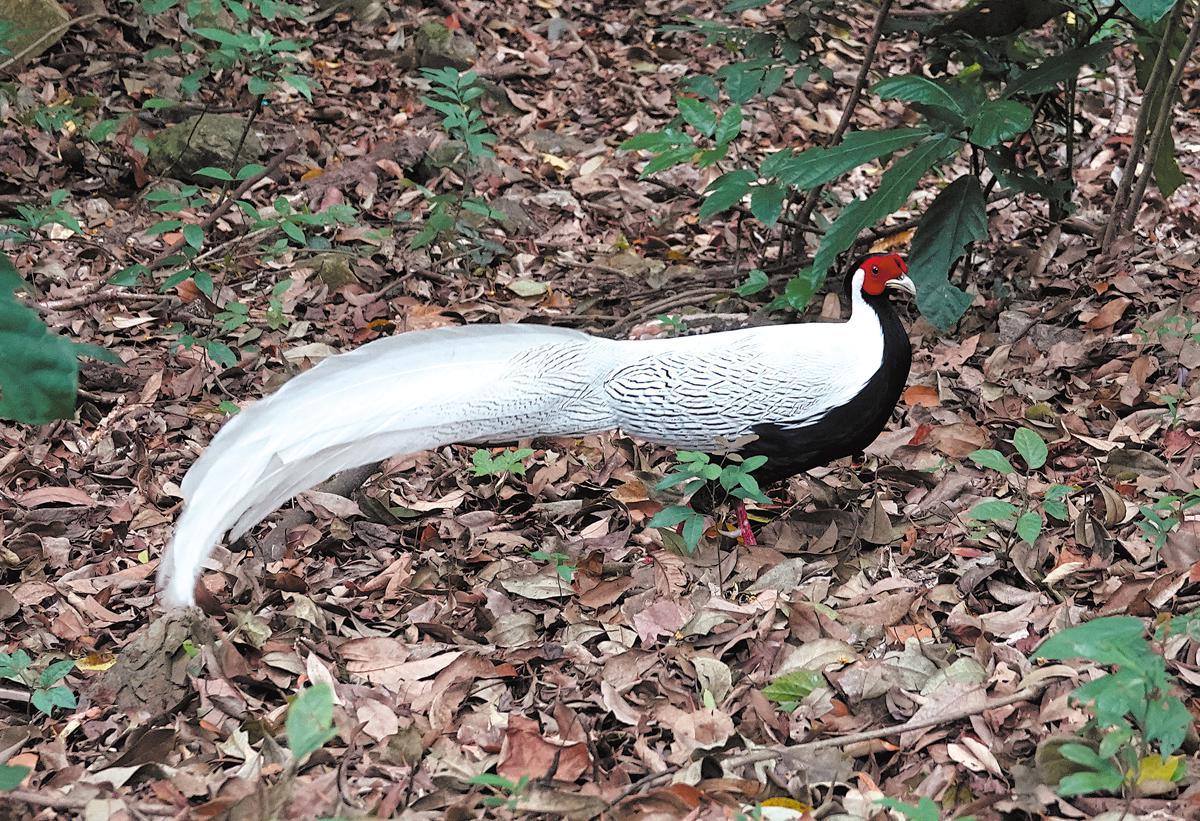

Visitors admire a waterfall in Dinghu Mountain reserve in May last year. (Liu Chunlin/Xinhua)
Many regions across the globe located along the Tropic of Cancer are arid deserts, yet Dinghu Mountain National Nature Reserve in Zhaoqing, Guangdong province, stands as an ecological outlier with a 98 percent forest coverage rate.
As China's first national nature reserve, this primeval forest — referred to as the "Green Pearl on the Tropic of Cancer Desert Belt" — harbors 2,291 species of higher plants and 277 species of birds, and the groundbreaking scientific achievements made in the reserve have revolutionized global understanding of forest carbon sequestration.
Species gene bank
In the 1920s, a group of botanists, including Chen Huanyong, the first director of the South China Botanical Garden of the Chinese Academy of Sciences, discovered the rich biodiversity of Dinghu Mountain during field research.
They recognized it as a natural species gene bank vital for scientific study, and thus advocated for the preservation of its natural vegetation.
"At that time, scientists represented by Chen realized that the development of the new China must prioritize natural conservation. They were pioneers in establishing nature reserves," said Xia Hanping, director of the Dinghu Mountain reserve's administration bureau.
Thanks to their advocacy, the Dinghu Mountain National Nature Reserve was established in 1956.
From its inception, scientists and forest rangers have worked generation after generation, dedicating themselves to scientific conservation methods to protect and preserve Dinghu Mountain.
"Initially, 82 percent of Dinghu Mountain consisted of non-native forests and even barren hills. Through measures like closing off the mountain for reforestation and precise cultivation, the forest coverage is above 98 percent, and biodiversity has been protected," said Xia, who has worked at Dinghu Mountain for over three years.
"Discovering 17.8 new species per square kilometer is rare among natural reserves nationwide," Xia said. The Dinghu Mountain model has yielded 202 species, with 44 directly named after Dinghu, like the Didymocarpus dinghushanensisand Lysimachia dinghushanensis.
In 2018, the first footage of a Chinese pangolin was captured in Dinghu Mountain, a species missing for over 30 years, using infrared cameras, further underscoring its unique value as a species gene bank.

A silver pheasant wanders Dinghu Mountain reserve in April. (Sun Zifa/China News Service)
Carbon sequestration
Forests are substantial carbon sinks, absorbing carbon dioxide. Scientists estimate forest carbon stocks to assess their crucial role in mitigating global climate change.
In China, there are over 7,800 sample plots used by scientists to estimate forest carbon stocks. The Dinghushan Forest Ecosystem Research Station was established by the CAS in 1978. In 1999, it became one of the first national field scientific observation pilot stations, making it a key site for China's forest carbon stock evaluation.
"Since the industrial revolution, human activities have dramatically increased atmospheric CO2 concentration, leading to global warming and other crises. Yet, unexplained unknown carbon sinks' exist in the carbon cycle," explained Liu Juxiu, director of the Dinghushan station.
With the adoption of the Kyoto Protocol in 1997, understanding carbon sources and sinks became crucial not only for ecological science but also for international politics and economics, affecting emission reduction responsibilities and sustainable development paths, Liu added.
"Over the past two decades, the Dinghushan station has focused extensively on the structure and function of tropical and subtropical forest ecosystems and their evolution patterns, achieving numerous internationally impactful scientific results," she said. These achievements earned the National Natural Science Award's second prizes for the years 2008 and 2023.
In 2006, a research paper published in Science by the research team caused a global sensation.
The 0-20 centimeter soil layer in a 400-year-old primeval forest in Dinghu Mountain was accumulating organic carbon at a surprising average rate, challenging the traditional "zero carbon sink" notion of mature forests and opening new paths for global carbon cycle research and climate change mitigation.
"Sustained 24-year monitoring data was the key to the breakthrough," Liu said.
The research team systematically analyzed data from 1979 to 2003, proving for the first time the sustained carbon sequestration ability of mature forests.
Based on this discovery, the team proposed a "non-equilibrium theory framework" for ecosystems, significantly influencing global carbon cycle research.
Carbon emission rights have always drawn significant international attention. In global climate negotiations, fair distribution of carbon rights is a core issue.
"A scientific, rigorous and convincing carbon ledger is essential for securing national development rights in international climate negotiations," Liu said, adding that several research findings from the reserve directly support China's climate diplomacy and dual carbon strategic implementation.
Over the past 20 years, the team has poured much effort into terrestrial ecosystem carbon sequestration research, integrating data from systematic surveys of 14,371 sample plots across China's forests, shrubs, grasslands and farmlands to estimate the country's terrestrial ecosystem carbon stocks and creating a comprehensive map for them.
"Research proves that China's terrestrial ecosystems still have significant carbon sequestration potential," Liu said.
"Estimates based on forest vegetation and surface waters of carbonate rocks indicate that China's terrestrial carbon sequestration capacity has been underestimated by about 50 percent, largely influenced by regional environmental changes. These findings propose different driving mechanisms for terrestrial carbon sequestration, crucial for rebalancing regional and global carbon cycles. This presents both opportunities and challenges," she said.
"To better serve the national dual carbon strategy, we began constructing an integrated observation platform in 2022, including atmospheric flux towers for comprehensive environmental monitoring and data collection from surface, meteorological and satellite imagery, creating a survey-observation-simulation carbon sequestration research system," said Liu. They also plan to build an underground observation well for critical zone research.
Ecological governance
Joining UNESCO's "Man and the Biosphere" program in 1980, Dinghushan station pioneered the "core zone-buffer zone-experimental zone" management model. "We adhere to complete prohibition in the core zone and balanced scientific research in the experimental zone," Liu said. This graded protection concept has become widespread across national nature reserves.
Dinghushan station's ecological value extends beyond its own region, with flourishing international cooperation. Since the first international collaboration with Illinois State University in 1988, the station has engaged in long-term research with over 20 international scientific institutions, hosting global events like strategic meetings for the International Long-Term Ecological Research Network, becoming a global observatory laboratory.
Under the "Man and the Biosphere" framework, the "forest ecosystem carbon sequestration model" was included in the United Nations climate change assessment report, providing a reference for developing countries in addressing climate crises, making Dinghu Mountain a global benchmark for ecological research. (China Daily)

86-10-68597521 (day)
86-10-68597289 (night)

52 Sanlihe Rd., Xicheng District,
Beijing, China (100864)

